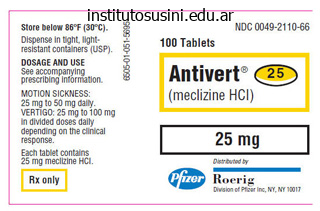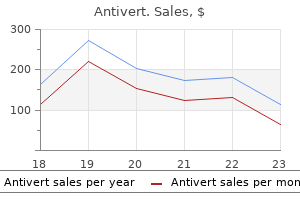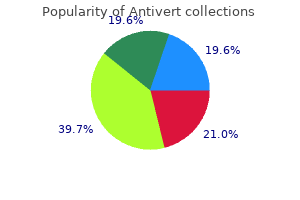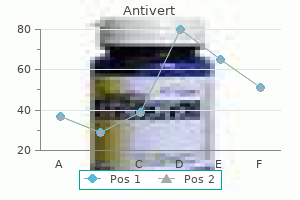

Antivert dosages: 25 mg
Antivert packs: 60 pills, 90 pills, 120 pills, 180 pills, 270 pills, 360 pills

All three passively diffuse into the descending limb but either diffuse or are actively pumped out again by the ascending limb as the cycle repeats itself over and over medications qd discount 25 mg antivert otc. The sodium chloride-urea trap thus formed establishes an osmotic gradient that increases in strength toward the renal papillae. This gradient is important for the conservation of water and formation of hypertonic urine by the terminal portion of the distal tubule and the collecting ducts. The lining epithelium of the collecting ducts consists of principal and intercalated cells. The principal (light) cells generally are cuboidal with centrally placed, round nuclei and lightly staining cytoplasm with characteristic, distinct cell boundaries. Ultrastructurally, the light cells show scattered, short microvilli on their apical surfaces, scattered mitochondria, and some infolding of the basal plasmalemma. The initial segment is found in the cortex and includes short connecting portions that unite the distal tubules of cortical nephrons to collecting ducts and arched portions that are formed by the confluence of several connecting portions from juxtamedullary nephrons. The arched portions originate deep in the cortex, which they ascend through before arching to descend within a medullary ray. As the ducts pass through the medulla they converge to form larger, straight collecting ducts called papillary ducts, which end at the tip of a renal papilla. The numerous openings of the papillary ducts give a sieve like appearance to the external surface of the papillae; this area has been called the area cribrosa. A scanning electron micrograph of a portion of a human collecting tubule as viewed from the lumen demonstrating the surface features of light (principal) and dark (intercalated) cells. Scattered between the light cells are the intercalated (dark) cells, which have more mitochondria, stain more deeply, and show a large number of vesicles in the apical cytoplasm. A small population of intercalated cells (cells) have been observed that function opposite the form and secrete potassium ion. As the collecting tubules pass through the medulla, the cells increase in height to become tall columnar in the papillary ducts. The mechanism of ammonia excretion is complex and follows a circuitous route to be excreted indirectly. The amount of ammonia (hydrogen ion) secreted is dependent largely on the acid/base status of the extracellular fluids.

Salivary Glands medicine pill identification antivert 25 mg discount free shipping, Inflammation, Acute Chronic P Parasitic Cyst Parasitic cyst is extremely uncommon and is usually identified as a hydatid cyst. On imaging alone, differentiation between hydatid and other cystic lesion is difficult; serologic tests may be useful in the appropriate clinical setting. Cystic Neoplasms, Pancreatic Passive Targeting A nonspecific accumulation of microbubbles at the target site after their administration and does not require a shell labeling with specific ligands. Cutaneous Lesions, Breast Pediatric Radiology Pediatric radiology is one of the recognized subspecialty areas of radiology. In the last decade remarkable advances in the ability to vividly image both normal and abnormal anatomic and functional aspects have been accomplished. Various imaging modalities, such as ultrasonography, projection radiography, computed tomography, magnetic resonance imaging, angiography, and nuclear medicine examinations are applied to children. Technology and techniques must be tailored with respect to their particular advantages and disadvantages related to their properties and to the specific requirements of children. Not only anatomy and physiology differ from the adult situation; there are also specific pediatric diseases and conditions, congenital malformations, and problems in neonates and preterm babies. Further specific adaptations of imaging protocols and techniques are essential to reduce radiation hazards to neonates, infants, and children. Additionally, pediatric radiology tries to promote and use nonionizing imaging techniques leading to different imaging algorithms compared to adult radiology. This entry tries to include all relevant aspects of pediatric radiology from head to toe focusing on those conditions that significantly differ from imaging in adults. The utility and limitations of modalities will be presented for each particular disease and clinical situation enabling a profound knowledge and understanding much easier than by retrieving the respective information. Perception, understanding, and interpretation of imaging findings require a profound knowledge of anatomy throughout childhood as well as of physiology of growth with consecutive changing imaging patterns during growth. Pediatric Hepatic Neoplasms Hepatic Pediatric Tumors, Benign Pediatric Liver Tumors Hepatic Pediatric Tumors, Benign Pediatric Neoplasms of the Liver Hepatic Pediatric Tumors, Benign Pediatric Posterior Fossa Tumors Histologies of brain tumors differ completely between adults and children, so age is the main predictive factor. The most frequent tumors in the posterior fossa in children are pilocytic astrocytoma, medulloblastoma, ependymoma, and brain stem glioma. Neoplasms, Brain, Posterior Fossa, Pediatric Pelvic Cavity 1461 Pediatric radiology includes two major areas: imaging of congenital diseases and malformations and assessment of acquired disease.

The veins are usually insufficient to bypass the entire splenomesenteric inflow medications you cannot eat grapefruit with antivert 25 mg cheap with amex, and signs of portal hypertension frequently co-exist. Clinical signs of portal cavernoma are usually related to extra-hepatic portal hypertension (bleeding from oesophageal varices, splenomegaly, etc. An increased flow in hepatic artery may be seen, representing a compensatory mechanism to the reduced portal flow. Any increase in the portal vein pressure due to obstruction to blood flow in the portal venous system. Pathology/Histopathology Portal hypertension can be classified into five major types relative to location of portal flow obstruction: 1. Extra-hepatic (portal or splenic vein thrombosis or obstruction, arterioportal fistula) 2. Intra-hepatic pre-sinusoidal (congenital hepatic fibrosis, primary biliary cirrhosis, schistosomiasis, sarcoidosis, myelofibrosis) Portal Hypertension, Adults 1521 3. Intra-hepatic post-sinusoidal (alcoholic cirrhosis, veno-occlusive disease, obstruction or compression of hepatic veins) 5. When the pressure in the portal venous system becomes higher than the systemic venous pressure, a reversal of flow occurs and porto-systemic shunts develop. Since in post-uterine life the portal venous system is without valves, blood can flow in any direction, and when normal or hepatopetal flow is blocked, blood is free to flow along the course of least resistance (tributary or newly developed collaterals). Tributary collaterals are represented by the normal tributaries of the portal system that are immediately available for collateral blood flow. These important tributaries are the left gastric vein, the short gastric veins, the superior mesenteric vein and the inferior mesenteric vein. Blood flowing in reverse direction over the left gastric vein and the short gastric veins reaches the systemic circulatory system via the emiazygos and azygos systems.

The condition may affect the entire spine as in achondroplasia medications covered by blue cross blue shield discount 25 mg antivert with amex, but usually sections of the spine are more severely involved than others. Spinal stenosis manifests itself most frequently in the lumbar spine, is encountered less frequently in the cervical region and is occasionally seen limited to the thoracic spinal canal. According to the reports by Mixter and Barr on lumbar disc herniation as a cause of low back pain with sciatica, the 1930s and 1940s could be described as the "decades of the disc" as far as concepts on causes of low back pain and sciatica were concerned. In the 1950s and 1960s, the realization began to grow that, besides being caused by herniation of the lumbar intervertebral disc, low back complaints irradiating to the legs could also be due to reduced dimensions of the spinal canal or, quite frequently, to a combination of these two conditions. S 1752 Stenosis, Spinal It was also recognized that long-tract spinal cord symptoms originating in the cervical region were caused frequently by spinal cord compression due to narrowing of the cervical spinal canal and not by a disease of the cord itself. Understanding of etiology, symptomatology, and diagnosis in patients with spinal stenosis is greatly enhanced by insight into the effects of postural changes, such as lordosis and kyphosis upon spinal structures and the contents of the spinal canal. Etiology, Pathology the classification of causes of spinal stenosis is extensive (1). The original report by Verbiest (2) described seven patients with what was thought to be developmental narrowness of the lumbar spinal canal, with heavily developed laminae and articular processes compressing the dural sac. In fact this classic form of stenosis is quite rare, and the most important single cause of spinal narrowing is considered to be degenerative. Epstein focused attention on abnormal narrowing of the lateral recesses of the spinal canal and of the intervertebral foramina as a cause of chronic sciatica (3). The application of computed tomography to spinal imaging in the 1970s and 1980s provided new insights into the various factors causing narrowing of the spinal canal and compression of the dural sac or the emerging nerve root. Combinations of these factors in spinal stenosis are the rule rather than the exception (4). In the lumbar region the spinal canal may be somewhat narrowed on developmental basis. This need not cause symptoms by itself, but in later life degenerative hypertrophy of the facets and flaval ligaments may further reduce spinal Stenosis, Spinal.

Grok, 49 years: In some pathologic conditions, the liver and spleen may resume a role in hemopoiesis. This provides a metabolic advantage for this cell type in that glucose does not have to be phosphorylated and is available to provide energy directly by glycolysis. Infected Necrosis, Pancreatic Pancreatic necrosis is a diffuse or focal area of nonviable pancreatic parenchyma, which is typically associated to acute pancreatitis with peripancreatic fat necrosis. However, there is low sensitivity to internal cartilage matrix changes and differentiation of cartilage from the joint surface can be difficult in (especially proteinaceous) joint effusion.
Goran, 63 years: Later in development, most of the processus vaginalis is obliterated except at its distal end, which remains as a peritoneal sac called the tunica vaginalis of the testes. The average age of patients at diagnosis is 43 years, with renal infection rarely occurring before 20 years of age. Sensation is thought to be perceived by the processes of odontoblasts, which in turn transmit the sensory stimulation to adjacent nerves in the pulp chamber. With a considered splenectomy, the contribution of the spleen to erythropoiesis must be taken into account (compare to ferrokinetic).
Hauke, 32 years: Your fourth and subsequent attempts must be at least 12 months after your first attempt at that exam and at least six months after your most recent attempt at that exam. However, in some cases obstruction may not be the predominant feature and the infant may present with diarrhoea or an enterocolitis. The classic presentation is with acute severe ipsilateral loin to groin pain, associated with nausea and vomiting. Therearevesicularlesionsonthelips,gumsand anteriorsurfacesofthetongueandhardpalate,which often progress to extensive, painful ulceration with bleeding(Fig.
Sobota, 39 years: An enlarged labial frenum has been blamedfor most persistent diastemas, but its etiologic role nowis understood to represent only a small proportion of cases. Unfortunately, imaging methods are often unable to differentiate inflammatory and neoplastic nodes. The requirement of these technical skills did much to establish neuroradiology as a separate radiological subspecialty, practiced by dedicated radiologists, and not infrequently by neurosurgeons and neurologists. Only after the airway is secured should bloodbetakenforcultureandintravenousantibiotics such as cefuroxime started.
Jose, 24 years: Breasts (Mammary Glands) Mammary glands are present in both sexes but in men remain rudimentary throughout life. Proteins work in concerto and constantly influence each others functions through different temporal and spatial interactions with one another. Several patterns that reflect progressive stages of fibroblastic differentiation are identified microscopically in fibromatosis. A scanning electron micrograph illustrating isolated villi and intestinal glands of the duodenum.
Ben, 40 years: Signs like focal calcifications and irregular lowdensity areas in a mass are also suggestive for leiomyomas. Neoplasms, Urethra Involuntary urinary loss during all usual situations or activities. Reversal of blockade-neostigmine (must be given with atropine to prevent muscarinic effects such as bradycardia), edrophonium, and other cholinesterase inhibitors. The clustering and subsequent lack of ossification of the zones between the clusters, within the primary spongiosa zone of the metaphysis, may account for the enchondromatous areas in achondroplasia metaphyses and diametaphyses.